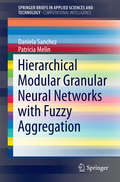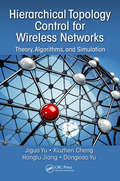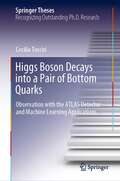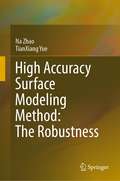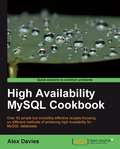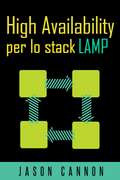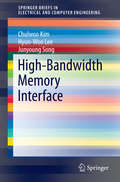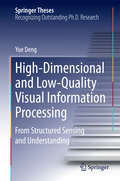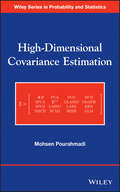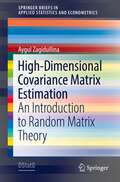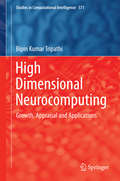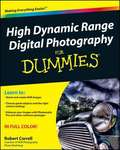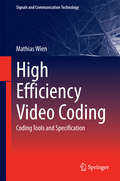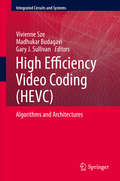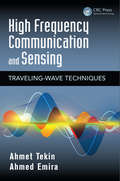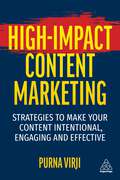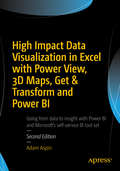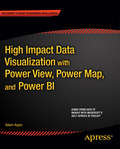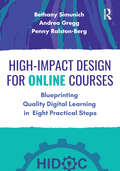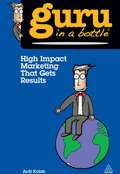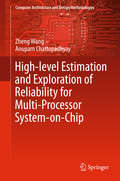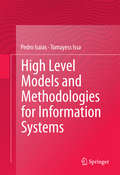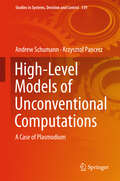- Table View
- List View
Hierarchical Modular Granular Neural Networks with Fuzzy Aggregation
by Daniela Sanchez Patricia MelinIn this book, anew method for hybrid intelligent systems is proposed. The proposed method isbased on a granular computing approach applied in two levels. The techniquesused and combined in the proposed method are modular neural networks (MNNs)with a Granular Computing (GrC) approach, thus resulting in a new concept ofMNNs; modular granular neural networks (MGNNs). In addition fuzzy logic (FL)and hierarchical genetic algorithms (HGAs) are techniques used in this researchwork to improve results. These techniques are chosen because in other workshave demonstrated to be a good option, and in the case of MNNs and HGAs, thesetechniques allow to improve the results obtained than with their conventionalversions; respectively artificial neural networks and genetic algorithms.
Hierarchical Topology Control for Wireless Networks: Theory, Algorithms, and Simulation
by Jiguo Yu Cheng Xiuzhen Jiang Honglu Dongxiao YuFirst Published in 2018. Routledge is an imprint of Taylor & Francis, an Informa company.
Higgs Boson Decays into a Pair of Bottom Quarks: Observation with the ATLAS Detector and Machine Learning Applications (Springer Theses)
by Cecilia TosciriThe discovery in 2012 of the Higgs boson at the Large Hadron Collider (LHC) represents a milestone for the Standard Model (SM) of particle physics. Most of the SM Higgs production and decay rates have been measured at the LHC with increased precision. However, despite its experimental success, the SM is known to be only an effective manifestation of a more fundamental description of nature. The scientific research at the LHC is strongly focused on extending the SM by searching, directly or indirectly, for indications of New Physics. The extensive physics program requires increasingly advanced computational and algorithmic techniques. In the last decades, Machine Learning (ML) methods have made a prominent appearance in the field of particle physics, and promise to address many challenges faced by the LHC.This thesis presents the analysis that led to the observation of the SM Higgs boson decay into pairs of bottom quarks. The analysis exploits the production of a Higgs boson associated with a vector boson whose signatures enable efficient triggering and powerful background reduction. The main strategy to maximise the signal sensitivity is based on a multivariate approach. The analysis is performed on a dataset corresponding to a luminosity of 79.8/fb collected by the ATLAS experiment during Run-2 at a centre-of-mass energy of 13 TeV. An excess of events over the expected background is found with an observed (expected) significance of 4.9 (4.3) standard deviation. A combination with results from other \Hbb searches provides an observed (expected) significance of 5.4 (5.5). The corresponding ratio between the signal yield and the SM expectation is 1.01 +- 0.12 (stat.)+ 0.16-0.15(syst.).The 'observation' analysis was further extended to provide a finer interpretation of the V H(H → bb) signal measurement. The cross sections for the VH production times the H → bb branching ratio have been measured in exclusive regions of phase space. These measurements are used to search for possible deviations from the SM with an effective field theory approach, based on anomalous couplings of the Higgs boson. The results of the cross-section measurements, as well as the constraining of the operators that affect the couplings of the Higgs boson to the vector boson and the bottom quarks, have been documented and discussed in this thesis. This thesis also describes a novel technique for the fast simulation of the forward calorimeter response, based on similarity search methods. Such techniques constitute a branch of ML and include clustering and indexing methods that enable quick and efficient searches for vectors similar to each other. The new simulation approach provides optimal results in terms of detector resolution response and reduces the computational requirements of a standard particles simulation.
High Accuracy Surface Modeling Method: The Robustness
by Na Zhao TianXiang YueThis book focuses on the robustness analysis of high accuracy surface modeling method (HASM) to yield good performance of it. Understanding the sensitivity and uncertainty is important in model applications. The book aims to advance an integral framework for assessing model error that can demonstrate robustness across sets of possible controls, variable definitions, standard error, algorithm structure, and functional forms. It is an essential reference to the most promising numerical models. In areas where there is less certainty about models, but also high expectations of transparency, robustness analysis should aspire to be as broad as possible. This book also contains a chapter at the end featuring applications in climate simulation illustrating different implementations of HASM in surface modeling. The book is helpful for people involved in geographical information science, ecological informatics, geography, earth observation, and planetary surface modeling.
High Anxieties: Cultural Studies in Addiction
by Janet Farrell Brodie Marc RedfieldThe essays collected in this volume describes connections between our notions of "addiction" and "culture" that go far beyond the commonplace that addiction, like any representable entity or event, is a phenomenon with a cultural side to it.
High Availability MySQL Cookbook
by Alex DaviesThis book uses the approach of a cookbook. Each recipe provides the reader with easy step-by-step descriptions of the actions necessary to accomplish a specific task. It is designed to present what often appear as extremely complicated techniques as a series of simple-to-follow recipes, allowing readers to achieve high uptimes on their MySQL servers. This book is targeted at system administrators or database administrators who have basic familiarity with Linux, the shell, and MySQL. The typical user will be able to get MySQL installed and working, but needs practical guidance to make it highly available.
High Availability Per Lo Stack Lamp
by Eugenia Franzoni Jason CannonUno dei modi più comuni di rendere disponibili le applicazioni web è attraverso lo stack LAMP. LAMP è un acronimo che sta per Linux, Apache, MySQL e PHP; in questo ambiente, Linux è il sistema operativo, Apache il server web, MySQL il server di database e PHP il linguaggio di programmazione. Questa architettura può essere utilizzata per servire applicazioni open source o anche app personalizzate. Siti web famosissimi come Facebook, Wikipedia e Yahoo usano questo ambiente per servire le loro applicazioni a milioni di utenti in tutto il mondo, e anche moltissime applicazioni open source, quali WordPress, Drupal, Joomla! MediaWiki e SugarCRM, si appoggiano allo stack LAMP. Che stiate implementando o facendo da piattaforma ad un'applicazione personalizzata, o che stiate usando una soluzione open source, dovreste usare un'architettura che massimizzi il tempo di uptime dell'applicazione, elimini i single point of failure, permetta di scalare senza tempo di fermo, e sia relativamente semplice da implementare e supportare. È meglio prendersi il tempo all'inizio per tenere in considerazione i requisiti e gli obiettivi a lungo termine del servizio che state implementando, invece di prendere decisioni sull'architettura durante un momento di emergenza come può essere un potenziale aumento del traffico o un'interruzione dell'elettricità. Fare queste cose durante un'emergenza non è il modo migliore di gestirle. Ogni progetto può avere requisiti diversi, ma in genere ci sono solo alcuni punti importanti da considerare di sicuro: la ridondanza, la scalabilità, le prestazioni e la gestione. La ridondanza è come si riesca a reagire ad eventuali guasti, la scalabilità è la possibilità di gestire una base di utenti più grande o più piccola, le prestazioni implicano assicurarsi che l'esperienza di ciascun utente sia ad un livello almeno accettabile. Avere un servizio ridondante, scalabile e ad alte prestazioni non serve a niente se non si riesce a gest
High-Bandwidth Memory Interface
by Chulwoo Kim Junyoung Song Hyun-Woo LeeThis book provides an overview of recent advances in memory interface design at both the architecture and circuit levels. Coverage includes signal integrity and testing, TSV interface, high-speed serial interface including equalization, ODT, pre-emphasis, wide I/O interface including crosstalk, skew cancellation, and clock generation and distribution. Trends for further bandwidth enhancement are also covered.
High-Dimensional and Low-Quality Visual Information Processing
by Yue DengThis thesis primarily focuses on how to carry out intelligent sensing and understand the high-dimensional and low-quality visual information. After exploring the inherent structures of the visual data, it proposes a number of computational models covering an extensive range of mathematical topics, including compressive sensing, graph theory, probabilistic learning and information theory. These computational models are also applied to address a number of real-world problems including biometric recognition, stereo signal reconstruction, natural scene parsing, and SAR image processing.
High-Dimensional Covariance Estimation
by Mohsen PourahmadiMethods for estimating sparse and large covariance matricesCovariance and correlation matrices play fundamental roles in every aspect of the analysis of multivariate data collected from a variety of fields including business and economics, health care, engineering, and environmental and physical sciences. High-Dimensional Covariance Estimation provides accessible and comprehensive coverage of the classical and modern approaches for estimating covariance matrices as well as their applications to the rapidly developing areas lying at the intersection of statistics and machine learning.Recently, the classical sample covariance methodologies have been modified and improved upon to meet the needs of statisticians and researchers dealing with large correlated datasets. High-Dimensional Covariance Estimation focuses on the methodologies based on shrinkage, thresholding, and penalized likelihood with applications to Gaussian graphical models, prediction, and mean-variance portfolio management. The book relies heavily on regression-based ideas and interpretations to connect and unify many existing methods and algorithms for the task.High-Dimensional Covariance Estimation features chapters on:Data, Sparsity, and RegularizationRegularizing the EigenstructureBanding, Tapering, and ThresholdingCovariance MatricesSparse Gaussian Graphical ModelsMultivariate RegressionThe book is an ideal resource for researchers in statistics, mathematics, business and economics, computer sciences, and engineering, as well as a useful text or supplement for graduate-level courses in multivariate analysis, covariance estimation, statistical learning, and high-dimensional data analysis.
High-Dimensional Covariance Matrix Estimation: An Introduction to Random Matrix Theory (SpringerBriefs in Applied Statistics and Econometrics)
by Aygul ZagidullinaThis book presents covariance matrix estimation and related aspects of random matrix theory. It focuses on the sample covariance matrix estimator and provides a holistic description of its properties under two asymptotic regimes: the traditional one, and the high-dimensional regime that better fits the big data context. It draws attention to the deficiencies of standard statistical tools when used in the high-dimensional setting, and introduces the basic concepts and major results related to spectral statistics and random matrix theory under high-dimensional asymptotics in an understandable and reader-friendly way. The aim of this book is to inspire applied statisticians, econometricians, and machine learning practitioners who analyze high-dimensional data to apply the recent developments in their work.
High Dimensional Neurocomputing
by Bipin Kumar TripathiThe book presents a coherent understanding of computational intelligence from the perspective of what is known as "intelligent computing" with high-dimensional parameters. It critically discusses the central issue of high-dimensional neurocomputing, such as quantitative representation of signals, extending the dimensionality of neuron, supervised and unsupervised learning and design of higher order neurons. The strong point of the book is its clarity and ability of the underlying theory to unify our understanding of high-dimensional computing where conventional methods fail. The plenty of application oriented problems are presented for evaluating, monitoring and maintaining the stability of adaptive learning machine. Author has taken care to cover the breadth and depth of the subject, both in the qualitative as well as quantitative way. The book is intended to enlighten the scientific community, ranging from advanced undergraduates to engineers, scientists and seasoned researchers in computational intelligence.
High Dynamic Range Digital Photography For Dummies
by Robert CorrellCreate amazing HDR photos with this full-color, plain-English guide Your secret is safe with us. Even if you don't have the latest high-end high dynamic range (HDR) camera equipment, you can still create striking images that appear as if you do with the tips, tricks, and techniques in this helpful guide. Discover how to use bracketing effectively, get the most out of a tripod, finesse your photos with Photoshop, and make it all go easier with this practical and inspiring book. Shines a light on HDR-what it is, how it's done, and what tools you need Walks you through how to take good photographs, from using the right settings to choosing good HDR subjects Demonstrates how to put all your images together in a single photo, including selecting the software, establishing workflow, and creating files Covers how you can clean up digital residue, how to create HDR in black and white, and much more Packed with beautiful and inspiring full-color HDR images to fire your imagination Get fresh ideas, avoid mistakes, and produce memorable images with this essential guide.
High Efficiency Video Coding
by Mathias WienThe video coding standard High Efficiency Video Coding (HEVC) targets at improved compression performance for video resolutions of HD and beyond, providing Ultra HD video at similar compressed bit rates as for HD video encoded with the well-established video coding standard H. 264/AVC. Based on known concepts, new coding structures and improved coding tools have been developed and specified in HEVC. The standard is expected to be taken up easily by established industry as well as new endeavors, answering the needs of todays connected and ever-evolving online world. This book presents the High Efficiency Video Coding standard and explains it in a clear and coherent language. It provides a comprehensive and consistently written description, all of a piece. The book targets at both, newbies to video coding as well as experts in the field. While providing sections with introductory text for the beginner, it suits as a well-arranged reference book for the expert. The book provides a comprehensive reference for the technical details of the employed coding tools; it further outlines the algorithmic advances compared to H. 264/AVC. In addition to the technical aspects, the book provides insight to the general concepts of standardization, how specification text is written, and how these concepts apply to the HEVC specification.
High Efficiency Video Coding (HEVC)
by Vivienne Sze Madhukar Budagavi Gary J. SullivanThis book provides developers, engineers, researchers and students with detailed knowledge about the High Efficiency Video Coding (HEVC) standard. HEVC is the successor to the widely successful H. 264/AVC video compression standard, and it provides around twice as much compression as H. 264/AVC for the same level of quality. The applications for HEVC will not only cover the space of the well-known current uses and capabilities of digital video - they will also include the deployment of new services and the delivery of enhanced video quality, such as ultra-high-definition television (UHDTV) and video with higher dynamic range, wider range of representable color, and greater representation precision than what is typically found today. HEVC is the next major generation of video coding design - a flexible, reliable and robust solution that will support the next decade of video applications and ease the burden of video on world-wide network traffic. This book provides a detailed explanation of the various parts of the standard, insight into how it was developed, and in-depth discussion of algorithms and architectures for its implementation.
High Frequency Communication and Sensing: Traveling-Wave Techniques (Devices, Circuits, and Systems #35)
by Ahmet Tekin Ahmed EmiraHigh Frequency Communication and Sensing: Traveling-Wave Techniques introduces novel traveling wave circuit techniques to boost the performance of high-speed circuits in standard low-cost production technologies, like complementary metal oxide semiconductor (CMOS). A valuable resource for experienced analog/radio frequency (RF) circuit designers as well as undergraduate-level microelectronics researchers, this book: Explains the basics of high-speed signaling, such as transmission lines, distributed signaling, impedance matching, and other common practical RF background material Promotes a dual-loop coupled traveling wave oscillator topology, the trigger mode distributed wave oscillator, as a high-frequency multiphase signal source Introduces a force-based starter mechanism for dual-loop, even-symmetry, multiphase traveling wave oscillators, presenting a single-loop version as a force mode distributed wave antenna (FMDWA) Describes higher-frequency, passive inductive, and quarter-wave-length-based pumped distributed wave oscillators (PDWOs) Examines phased-array transceiver architectures and front-end circuits in detail, along with distributed oscillator topologies Devotes a chapter to THz sensing, illustrating a unique method of traveling wave frequency multiplication and power combining Discusses various data converter topologies, such as digital-to-analog converters (DACs), analog-to-digital converters (ADCs), and GHz-bandwidth sigma-delta modulators Covers critical circuits including phase rotators and interpolators, phase shifters, phase-locked loops (PLLs), delay-locked loops (DLLs), and more It is a significantly challenging task to generate and distribute high-speed clocks. Multiphase low-speed clocks with sharp transition are proposed to be a better option to accommodate the desired timing resolution. High Frequency Communication and Sensing: Traveling-Wave Techniques provides new horizons in the quest for greater speed and performance.
High-Impact Content Marketing: Strategies to Make Your Content Intentional, Engaging and Effective
by Purna VirjiCreate meaningful engagement, drive conversion rates and boost customer retention with this crucial resource to unlocking the true potential of your content marketing strategy.In an era of user-generated, human-generated and machine-generated content, mistakes are increasingly costlier to make. And more difficult to recover from. To succeed in the highly competitive creator economy of today and the future, content marketers need to rethink their approach or go the way of the dinosaurs.High-Impact Content Marketing shows how to succeed by taking a simplified yet strategic approach to standing out and driving revenue impact. It covers time-proven strategies to create video, audio, social media and longer-form content that audiences will actually want to consume and how to do so in a genuinely inclusive way. It also shows how to master content distribution across channels such as websites, blogs, email and social media networks to maximize reach, engagement and impact. What makes High-Impact Content Marketing unique is how it weaves in behavioral science and adult learning principles to maximize and measure impact. It features easy-to-implement frameworks and actionable guides throughout as well as examples of best-in-class content marketing from the likes of Patagonia, Microsoft, Spotify and Google plus interviews with top industry experts from across the globe. Guidance is also included on how to align content with various stages of the customer journey. This is an essential blueprint for ensuring the long-term success of your content marketing strategy to increase brand awareness, build relationships and boost conversions.
High Impact Data Visualization in Excel with Power View, 3D Maps, Get & Transform and Power BI
by Adam AspinTake business intelligence delivery to a new level that is interactive, engaging, even fun, all while driving commercial success through sound decision making. Do this through the power of visualization using this updated edition covering new features and added support for visualization in Excel 2016, and describing the latest developments in Get & Transform and DAX. The example data set has also been updated to demonstrate all that Microsoft's self-service business intelligence suite is now capable of. High Impact Data Visualization in Excel with Power View, 3D Maps, Get & Transform and Power BI, 2nd Edition helps in harnessing the power of Microsoft's flagship, self-service business intelligence suite to deliver compelling and interactive insight with remarkable ease. Learn the essential techniques needed to enhance the look and feel of reports and dashboards so that you can seize your audience's attention and provide them with clear and accurate information. Also learn to integrate data from a variety of sources and create coherent data models displaying clear metrics and attributes. Power View is Microsoft's ground-breaking tool for ad-hoc data visualization and analysis. It's designed to produce elegant and visually arresting output. It's also built to enhance user experience through polished interactivity. Power Map is a similarly powerful mechanism for analyzing data across geographic and political units. Get & Transform lets you load, shape and streamline data from multiple sources. Power Pivot can extend and develop data into a dynamic model. Power BI allows you to share your findings with colleagues, and present your insights to clients. High Impact Data Visualization in Excel with Power View, 3D Maps, Get & Transform and Power BI, 2nd Edition helps you master this suite of powerful tools from Microsoft. You'll learn to identify data sources, and to save time by preparing your underlying data correctly. You'll also learn to deliver your powerful visualizations and analyses through the cloud to PCs, tablets and smartphones. Simple techniques take raw data and convert it into information. Slicing and dicing metrics delivers interactive insight. Visually arresting output grabs and focuses attention on key indicators. What You Will Learn Produce designer output that will astound your bosses and peers. Drive business intelligence from Excel using BI in the Cloud. Gather source data from corporate and public sources. Integrate charts, maps, and tables to deliver visually stunning information. Discover new insights as you chop and tweak your data as never before. Adapt delivery to mobile devices. Outshine competing products and enhance existing skills. Who This Book Is For Any Power BI Desktop, Excel or SharePoint user. Business Intelligence developers, power users, IT managers, finance experts, and more can use this book to outshine the competition by producing high-impact business intelligence reporting on a variety of devices from a variety of sources.
High Impact Data Visualization with Power View, Power Map, and Power BI
by Adam AspinTake business intelligence delivery to a new level that is interactive, engaging, even fun, all while driving commercial success through sound decision making. Do this through the power of visualization using this updated edition covering new features and added support for visualization in Excel 2016, and describing the latest developments in Get & Transform and DAX. The example data set has also been updated to demonstrate all that Microsoft's self-service business intelligence suite is now capable of. High Impact Data Visualization in Excel with Power View, 3D Maps, Get & Transform and Power BI, 2nd Edition helps in harnessing the power of Microsoft's flagship, self-service business intelligence suite to deliver compelling and interactive insight with remarkable ease. Learn the essential techniques needed to enhance the look and feel of reports and dashboards so that you can seize your audience's attention and provide them with clear and accurate information. Also learn to integrate data from a variety of sources and create coherent data models displaying clear metrics and attributes. Power View is Microsoft's ground-breaking tool for ad-hoc data visualization and analysis. It's designed to produce elegant and visually arresting output. It's also built to enhance user experience through polished interactivity. Power Map is a similarly powerful mechanism for analyzing data across geographic and political units. Get & Transform lets you load, shape and streamline data from multiple sources. Power Pivot can extend and develop data into a dynamic model. Power BI allows you to share your findings with colleagues, and present your insights to clients. High Impact Data Visualization in Excel with Power View, 3D Maps, Get & Transform and Power BI, 2nd Edition helps you master this suite of powerful tools from Microsoft. You'll learn to identify data sources, and to save time by preparing your underlying data correctly. You'll also learn to deliver your powerful visualizations and analyses through the cloud to PCs, tablets and smartphones. Simple techniques take raw data and convert it into information. Slicing and dicing metrics delivers interactive insight. Visually arresting output grabs and focuses attention on key indicators. What You Will Learn Produce designer output that will astound your bosses and peers. Drive business intelligence from Excel using BI in the Cloud. Gather source data from corporate and public sources. Integrate charts, maps, and tables to deliver visually stunning information. Discover new insights as you chop and tweak your data as never before. Adapt delivery to mobile devices. Outshine competing products and enhance existing skills. Who This Book Is For Any Power BI Desktop, Excel or SharePoint user. Business Intelligence developers, power users, IT managers, finance experts, and more can use this book to outshine the competition by producing high-impact business intelligence reporting on a variety of devices from a variety of sources.
High-Impact Design for Online Courses: Blueprinting Quality Digital Learning in Eight Practical Steps
by Bethany Simunich Andrea Gregg Penny Ralston-BergHigh-Impact Design for Online Courses introduces higher education professionals to an eight-step course design model that leverages the unique considerations of online and hybrid modalities at each stage in the process. Though relevant to and informed by instructional designers and educational technologists, this book is specifically geared toward faculty who lack the administrative and technical supports they need to thrive in the new normal. Each chapter includes step-by-step guidance on learner analysis, course structure, appropriate activities and assessments, continuous improvement, and other key elements of a successful digital course. Teachers across disciplines and levels of experience will come away newly inspired and motivated with fresh insights into planning and drafting, practical tips for pedagogy and design, opportunities for self-reflection and course revision, and implications for learner-centered delivery.
High-Impact eportfolio Practice: A Catalyst for Student, Faculty and Institutional Learning
by Bret Eynon Laura M. GambinoAt a moment when over half of US colleges are employing ePortfolios, the time is ripe to develop their full potential to advance integrative learning and broad institutional change. The authors outline how to deploy the ePortfolio as a high-impact practice and describe widely-applicable models of effective ePortfolio pedagogy and implementation that demonstrably improve student learning across multiple settings. Drawing on the campus ePortfolio projects developed by a constellation of institutions that participated in the Connect to Learning network, Eynon and Gambino present a wealth of data and revealing case studies. Their broad-based evidence demonstrates that, implemented with a purposeful framework, ePortfolios correlate strongly with increased retention and graduation rates, broadened student engagement in deep learning processes, and advanced faculty and institutional learning. The core of the book presents a comprehensive research-based framework, along with practical examples and strategies for implementation, and identifies the key considerations that need to be addressed in the areas of Pedagogy, Professional Development, Outcomes Assessment, Technology and Scaling Up. The authors identify how the ePortfolio experience enhances other high-impact practices (HIPs) by creating unique opportunities for connection and synthesis across courses, semesters and co-curricular experiences. Using ePortfolio to integrate learning across multiple HIPs enables students reflect and construct a cohesive signature learning experience. This is an invaluable resource for classroom faculty and educational leaders interested in transformative education for 21st century learners.
High Impact Marketing That Gets Results
by Ardi KolahThis book will help you to use tried and tested no-fuss marketing methods to boost awareness of your brand among new and established customers. We'll give you the confidence to segment your market and customers so you can choose the right strategies for your business, products and services. You'll learn how to avoid costly mistakes with effective research and a practical marketing plan as well as how to use online marketing, PR, direct mail, promotions and other tools to run effective marketing campaigns that deliver measurable results. Jargon free, accessible, no detailed knowledge required, signposts the reader to all the important bits. The GURU is out of the BOTTLE!
High-level Estimation and Exploration of Reliability for Multi-Processor System-on-Chip
by Zheng Wang Anupam ChattopadhyayThis book introduces a novel framework for accurately modeling the errors in nanoscale technology and developing a smooth tool flow at high-level design abstractions to estimate error effects, which aids the development of high-level fault-tolerant techniques. In total, the book presents 6 solutions for reliability estimation (3 for fault injection and 3 for analytical estimation) and 5 techniques for reliability exploration (3 for architectural level and 2 for system-level). It also presents a survey of state-of-the-art problems and solutions, offering insights into reliability issues in digital design and their cross-layer countermeasures.
High Level Models and Methodologies for Information Systems
by Pedro Isaias Tomayess IssaIn this book the authors introduce and explain many methods and models for the development of Information Systems (IS). It was written in large part to aid designers in designing successful devices/systems to match user needs in the field. Chief among these are website development, usability evaluation, quality evaluation and success assessment. The book provides great detail in order to assist readers' comprehension and understanding of both novel and refined methodologies by presenting, describing, explaining and illustrating their basics and working mechanics. Furthermore, this book presents many traditional methods and methodologies in an effort to make up a comprehensive volume on High Level Models and Methodologies for Information Systems. The target audience for this book is anyone interested in conducting research in IS planning and development. The book represents a main source of theory and practice of IS methods and methodologies applied to these realities. The book will appeal to a range of professions that are involved in planning and building the information systems, for example information technologists, information systems developers, as well as Web designers and developers--both researchers and practitioners; as a consequence, this book represents a genuinely multi-disciplinary approach to the field of IS methods and methodologies.
High-Level Models of Unconventional Computations: A Case Of Plasmodium (Studies in Systems, Decision and Control #159)
by Krzysztof Pancerz Andrew SchumannThis book shows that the plasmodium of Physarum polycephalum can be considered a natural labelled transition system, and based on this, it proposes high-level programming models for controlling the plasmodium behaviour. The presented programming is a form of pure behaviourism: the authors consider the possibility of simulating all basic stimulus–reaction relations. As plasmodium is a good experimental medium for behaviouristic models, the book applies the programming tools for modelling plasmodia as unconventional computers in different behavioural sciences based on studying the stimulus–reaction relations. The authors examine these relations within the framework of a bio-inspired game theory on plasmodia they have developed i.e. within an experimental game theory, where, on the one hand, all basic definitions are verified in experiments with Physarum polycephalum and Badhamia utricularis and, on the other hand, all basic algorithms are implemented in the object-oriented language for simulations of plasmodia. The results allow the authors to propose that the plasmodium can be a model for concurrent games and context-based games.
